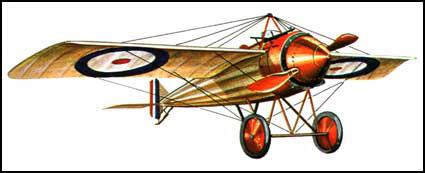Morane-Saulnier
Raymond Saulnier and the brothers, Robert Morane and Leon Morane, began producing aircraft in France in 1913. On the outbreak of the First World War the company joined with Roland Garros, to develop a system that would enable the pilot to fire the gun only when the propeller was out of line with the target. Early versions did not work properly and the pilots found they were destroying their propellers rather than enemy aircraft with their machine-gun fire.
In the early months of 1915, Roland Garros, added deflector plates to the blades of the propeller of his Morane-Saulnier L. These small wedges of toughened steel diverted the passage of those bullets which struck the blades. Over the next two weeks Garros shot down five enemy aircraft with his adapted Morane-Saulnier L. However, the success was short-lived because on 18th April, a German rifleman managed to fracture the petrol pipe of the aircraft that Garros was flying. Garros was forced to land behind the German front-line and both he his machine were captured by the Germans.
In 1914 the company also produced the Morane-Saulnier N. A plane of very advanced design, it was extremely fast but also difficult to handle. Its high landing speed resulted in a large number of crashes. Although rated high as a fighter plane, it was only given to highly experienced pilots to use over the Western Front.

Performance Data of the Morane-Saulnier N | |
|---|---|
Type | fighter |
Engine | 80 hp Le Rhone |
Wing Span | 26 ft 8 in (8.15 m) |
Length | 19 ft 1 in (5.83 m) |
Height | 7 ft 4 in (2.2 m) |
Maximum Speed | 90 mph (144 kph) |
Maximum Height | 13,123 ft (4,000 m) |
Endurance | 1 hour 30 minutes |
Armament | 1 machine-gun |
